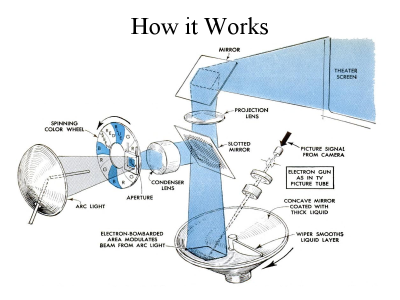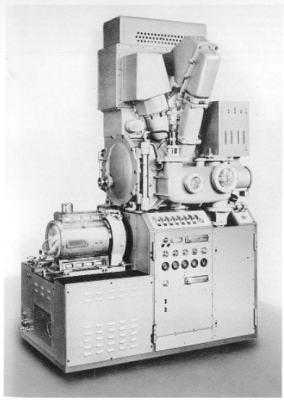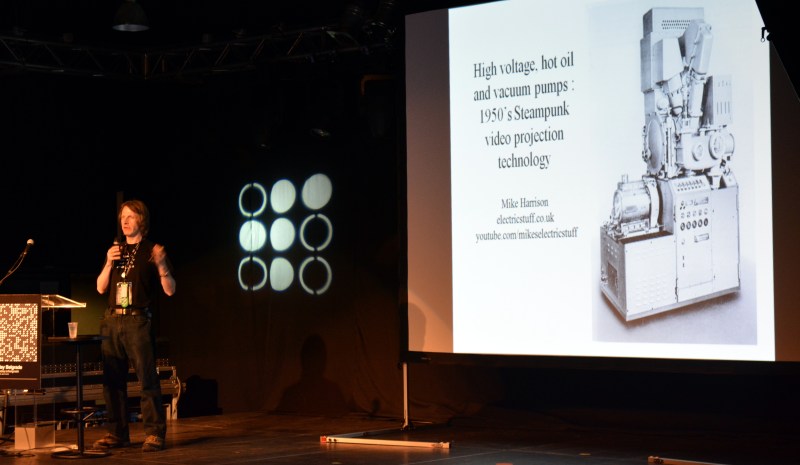It’s amazing how quickly a technological pivot will erase the existence of what was previously a modern marvel. A great example of this is the live video projection technology known as the Eidophor. In the beginning there was film, and if you shined a light through it followed by a set of lenses you could project an image for all to enjoy. But what if you didn’t want to wait for film to be developed? What if you wanted to project live video, or real-time data for a room full of people who could not be served by even the biggest of the cathode-ray tubes of the time? This question led to the development of the Eidophor whose story has been all but lost.
Mike Harrison is trying to revive the details of this amazing engineering feat and presented his findings during his talk at the Hackaday | Belgrade conference. Mike is interested in technology that is “impractical, ridiculous, absurd, or stupidly expensive” and the Eidophor certainly ticks all of those boxes. Check it out below and join us after the break where we’ll touch on the myriad challenges of developing projection technology based on hot oil and high voltage.
If we already had cathode ray tubes, why not use one of those as the light source for a projector system? The answer is that you can’t get enough light out of CRTs to make this feasible. The attempts made for this method drove them at really high voltage, pumped out X-rays which meant lead shielding was required, and any slight mishandling of the components would instantly burn out the system. A fundamentally different solution was necessary, and that would be the Eidophor. Some of the examples of Eidophor use include broadcasts of John Glenn in orbit in 1962, some of the screens in NASA mission control in 1969, and boxing broadcasts in the 1970’s.
 Development started by Dr. Fritz Fischer just before the second world war. The gist of the system is based on a parabolic mirror which focuses light on a slotted mirror. The light path then reflects on another mirror covered with a thin layer of oil and back through the slotted mirror to the projecting optics. The static state of the system lets no light through. However, if the oil film on the third mirror is disturbed it redirects the light slightly and allows it to pass through the slotted mirror. To project an image, the oil film is disturbed by an electron beam passing over its surface. At this point, anyone with even a basic understanding of these principles will recognize this as an incredibly complicated system to get working reliably.
Development started by Dr. Fritz Fischer just before the second world war. The gist of the system is based on a parabolic mirror which focuses light on a slotted mirror. The light path then reflects on another mirror covered with a thin layer of oil and back through the slotted mirror to the projecting optics. The static state of the system lets no light through. However, if the oil film on the third mirror is disturbed it redirects the light slightly and allows it to pass through the slotted mirror. To project an image, the oil film is disturbed by an electron beam passing over its surface. At this point, anyone with even a basic understanding of these principles will recognize this as an incredibly complicated system to get working reliably.
Charging the oil film just enough to get the intensity desired was quite a trick. The most successful method was by varying the speed — or velocity modulation — at which an electron beam passed over the surface, faster for less surface disturbance, and slower for more. The oil needs to be “refreshed” as the film builds up a charge over time. So this mirror rotates somewhat slowly while a wiper redistributes it in a uniform layer (presumably both thickness and charge).
 Mike does a great job of explaining the challenges that went into keeping an Eidophor working. It ran at vacuum but wasn’t totally sealed, so it either needed a few hours to get down to working vacuum or must be left on at all times. The oil film was very susceptible to vibrations so it needed to be big and heavy. The filaments driving these were specialized and burnt out frequently, after about fifty hours of use. And get this, the result was a 2% light efficiency; 98% of the produced light never made it to the screen!
Mike does a great job of explaining the challenges that went into keeping an Eidophor working. It ran at vacuum but wasn’t totally sealed, so it either needed a few hours to get down to working vacuum or must be left on at all times. The oil film was very susceptible to vibrations so it needed to be big and heavy. The filaments driving these were specialized and burnt out frequently, after about fifty hours of use. And get this, the result was a 2% light efficiency; 98% of the produced light never made it to the screen!
The advent of LCD projectors completely killed the Eidophor. It was already limited in use because of cost and complexity. The ability to shine light through an LCD and switch the frames electronically was a quantum leap in simplification and for the first time unlocked live video broadcast to the masses. But the engineering that went into earlier technology is well worth celebrating. Mike is looking for any leads on engineering manuals, or locations of Eidophors that survived. If you can help with that or any other information, let us know in the comments below.
If you’d like to see more of Mike Harrison’s work, check out his YouTube channel, mikeselectricstuff, his webpage, and follow @mikelectricstuf.
















Steampunk needs to stop being a label. This 1950’s projector is not a retrofuturistc Victorian era projector powered by steam, made of wood and brass and using a dynamo to project via carbon arc an image by using a reel of wetplate prints.
It’s a CRT projector and seriously amazing piece of tech, but people really need to stop throwing the label of steampunk at everything that is slightly complicated looking.
I agree. Steampunk is just another, dumber way of saying retrofuturistic and it drives me nuts.
+1
A pirate walks into a bar. The bartender notices that he has a ship wheel coming out of his pants.
Mostly out of curiosity the bartender asks; “Are you aware that there is a wheel coming out of your pants?”.
To which the pirate replies “aye it be drivin’ me nuts”
My very first post to HAD, just to say,
your a bad egg :P
& I’m stealing that to tell my grown up kids
Remind me of this http://youtu.be/TFCuE5rHbPA
I agree it’s not steam punk
I prefer how Professors Phil & Kaja Foglio put it to describe their webcomic “Girl Genius”: Gaslamp Fantasy.
Judging from most things I’ve seen labeled as steampunk, it appears to mean “I glued some brass gears on it.”
Maybe a little further. I didn’t want to get tattoos or piercings so I glued some brass tubing to my watch and glasses. Got a leather hat from a 1980’s women’s fashion consignment store and now I’m so cool that the opposite sex senses my power and keeps a safe distance.
Besides, that thing is the prototype of the Interocitor.
“Interocitor” – Everyone should build one, sourcing the parts is a bit of a problem though.
This drives me nuts too. Never understood why Tubepunk never seems to have caught on as a label – that was the term I knew the pre-transistor era engineering porn as. Think nixie tubes, stainless steel overbuilt.
There is also the very interesting era of gas plants and various manufactured gases before natural gas (LNG) sorta displaced that tech – electricity was the main displacement though for the gas plants. But that era kinda/sorta overlaps with steam era, but it often gets munched into it because well gas lamps also were brass I guess?
“The advent of LCD projectors completely killed the Eidophor.”
Incorrect. The advent of CRT projectors completely killed it. CRT projectors were way, way, WAY, before LCD.
Watch the video. He goes over how CRT projectors were inadequate compared to the eidophor and later LCD and DLP.
I have in the past 40 years removed tens of thousands of 210 pound AMPRO projectors, that did not need to be left running all the time and were highly common in Board rooms and the pentagon and even NASA from the late 1960’s to the 1990’s.The first LCD projector was sold in 1989 from projectavision.
It was highly common to stack 3 or more, triple gun CRT projectors to get significant output and the last ones would actually achieve HD resolutions back in 1992. Although ampros were outputting 4000 lumens in 1989 which were more than enough for most board rooms. Ediaphors are low resolution and CRT’s exceeded their abilities rapidly.
Lastly there was maybe a total of 10 Ediphors to exist at one time in the United states. CRT projectors utterly destroyed them in sales. And no companies wanted them due to their unreasonable size and power+cooling requirements.
Must have been good at adverting, if you were able to single highhandedly remove several units per day continuously for the last 40 years. Especially considering that Ampro only started selling CRT projectors in the ’80s so you must have been scrapping the first ones right after they were purchased.
Oh you are full of crap
if you want to pay the freight cost, I can let you have as many 3 CRT video projectors as you want.
These are cinema units and are still very bright, some are a bit fuzzy, but if you stuff around with focus they are ok.
that’s a great handle you have there, hiding in mums garage…
It’s not old Shitface, is it, who reached level 20 and evolved into a new form?
Wow, NASA alone owned 500 percent of all the Eidophors in the US?
The Louisian Superdome had six of them at one time…. I guess Nasa must have had the other four.
the cinema CRT projectors my friends company installed work REALLY well.
we were “acquiring” them from bin, most of them had a problem with the red CRT being low in output.
turning up the gun voltage works.
these CRT’s have a parabolic mirror in the rear of the tube, with the gun firing through the centre, the phosphor target is quite small, maybe 50mm in diameter, in a tube about 180mm diameter.
it is set up like a Cassegrain telescope.
I absolutely love this old, antiquated tech! I stumbled across this a few weeks ago; definitely the largest, craziest 3 gun projector I’ve seen reference of:
http://www.myvintagetv.com/amphion_600.htm
There was also the GE Talaria light valve video projector that used a light valve consisting of a rotating glass disc that was continuously re-coated with a viscous oil.
Did you watch the video?
No, I don’t have the luxury of watching random half-hour videos on weekdays except in the evenings. I had meant to watch this one but it got shoved down rather deep in the queue today for various tedious reasons.
Technically “Dieselpunk”, if you want to give it a punk-name.
It’s amazing how many old displays had moving parts and vacuums. Particularly the moving parts. Logie Baird’s first TV used electric motors in the camera and display. Really it was a pretty awful display, the eventual perfected version was still pretty low-res, and wasn’t going to get any better, it had reached the limits of the technology. It was Philo Farnsworth who invented the TV that people actually used.
“Farnsworth” A Warehouse 13 reference?
I think calling it “Vintage high tech” makes sense. Or in this case “Pre-CRT” would make sense. Or “Old Tech porn”.
No, the real dude. https://en.wikipedia.org/wiki/Philo_Farnsworth#Electronic_television Warehouse 13 referenced (as usual) reality.
Wermstrom!
Except that it’s post-CRT. And yep, the real Farnsworth, I think he’s the guy in Warehouse 13, he just invented a few extra things that weren’t so well-known.
Definitely nuclearpunk. See also: nixie tubes, Tek 500-series scopes.
Ah, atompunk!
Mikes looking good!
haven’t watched the video yet either, but thinking of complex systems has anyone played with a flying spot film to video transfer system. at least thats what i think they were used for.
More Nazi tech borrowed by NASA to help get them to the moon.
I’m leaning more towards joke than serious statement, considering Germany wasn’t even mentioned once, but anything’s possible with people.
Watch the video again more carefully, the device was invented by a German WWII era scientist, like a lot of the tech NASA used to get to the moon. Seriously I am not joking, if it was not for the pioneering work of all those German engineers and scientists the USA would have lost out to Russia completely.
If not for WW2, utilization of outer space would be even farther behind than it is now. Had the pace of the race kept up, the solar system today would be much like the science fiction authors of the 50’s and 60’s wrote about. Huge, rotating space stations, permanent Moon colonies. Asteroid mining. Perhaps even Mars colonies.
But even before the Apollo program began, NASA’s budget was being cut. Flushed the dream straight down the loo. Between Apollo 17 in 1972 and the launch of Columbia in 1981, only 12 Americans went to space. Three three man crews to Skylab and one three man crew to the “Let’s use the last usable Saturn rocket for a publicity stunt.” Apollo Soyuz flight. Meanwhile, the USSR launched several space stations and many more people. They were doing what NASA said the Shuttle would be doing, but failed to do – launch regularly and frequently.
Coincidently I just finished reading this, https://en.wikipedia.org/wiki/The_Moon_Is_a_Harsh_Mistress It makes you wonder what alternative futures could have been possible. The book is a fascinating foretelling of AI, and contemporary issue with the authenticity of recordings too.
A quantum leap is the change of energy state of an atom….
I think you might mean something along the lines of a paradigm shift or similar..
“Quantum leap” is generally used to mean a great change. Even though, literally, it means the smallest change it’s possible to have. Perhaps people think of Quantum Theory, which was a big change in how we thought about the world. The “leap” implies a biggish change, otherwise it’d be quantum creep.
I think the important part (which is used in both meanings) is that there is nothing between start and finish. That is, the path from one place (or technology level) to another has no intermediate points. “Quantum creep” sounds like a series of incremental, small changes, which is specifically what a quantum leap is not.
Good point! It’s not the magnitude, it’s the lack of intermediate steps. That’s probably what it meant when whoever it was first coined the phrase. You’ve changed my thinking on that.
Just so you know: The Eidophor was never “Nazi Tech”. It was originally invented in 1939 by Dr Fritz Fischer at the Swiss Federal Institute of Technology (ETH Zurich) and later manufactured by Gretag AG of Switzerland. Unlike other projection systems at the time, the Eidophor was able to work with TV signals. See http://www.ethistory.ethz.ch/besichtigungen/objekte/eidophor/
A Syracuse friend installed the teluria? Projectors for flight simulators for GE, said he crashed everything up to the shuttle!
10/10 as usual. Mike is the most interesting man on YouTube.
Mike I thoroughly resent the steampunk label affixed to
EIDOPHOR. I was about 9 when my father and LeonardoFerranti
toured the UK presenting the IEE lectures ..so this would have been about 1967.
The ststem was not the subject of the lectures but used to project an image up
to 90 feet square and I can tell you that when used with a reflective screen
it was incredibly bright and sharp….oh and black and white. I know that with
early lapel radio mics and a huge stage crew it was
absolutely cutting edge and drew gasps from the audience. There just wasnt
anything to compare it with. Clearly a lot of R and D went into this and I
am surprised that you are able to find little about it. Personally I would
do a little more real research than rely on the Internet for a presentation.